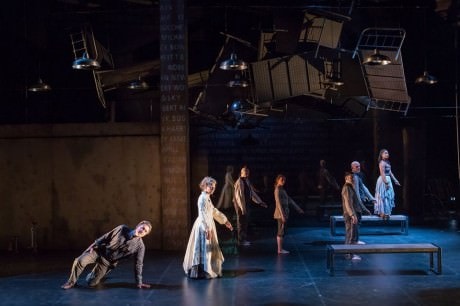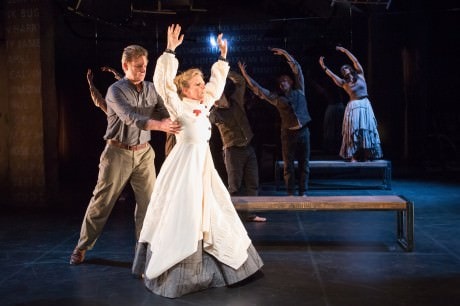The wars in Iraq and Afghanistan wage on; in Syria, the blood still flows, as it does in Somalia and South Sudan; in Mexico, death continues to pile up bodies in the drug war, as they do in America’s cities (not only from drugs but from gun play, alcohol, and psychological disorder.)
What is most surprising about Healing Wars, Liz Lerman’s interdisciplinary theatre-dance piece now playing at Arena Stage’s Kogod Cradle theatre, is how universal human suffering can be when stripped of the ideology, patriotic hymns, and political oratory that usually hides it. The agony that war, war of all stripes, brings to us all transports itself easily across time, moving from America’s bloody Civil War to America’s current wars. It no doubt would also easily transport itself across national boundaries: our citizens’ pain is the Syrians’ pain is the Afghani’s pain is even the Taliban’s pain.
For as Bill Pullman tells us at the opening of Healing Wars, when he describes how the 15-minute slaughter of the Minnesota 1st during the US Civil War wiped out the entire adult male population of a Minnesota county, it would not take too much empathy to feel the devastation that decades of war have reaped on Afghani communities, or Iraqi communities, or on Sudanese communities, or on Mexican communities, or on ….
Healing Wars is a cry of pain that no amount of ether can cure. The show offers no solution to challenge us, for as I suspect the only solution to the tragic suffering of war is the simplest: no more war and its weapons of death, to which an aroused citizenry cries, “Impossible!” And it is quite possible that our entire economic infrastructure would collapse without the war machinery that undergirds it.

Healing Wars is physical theatre at its finest: subtle, powerful, expressive, raw, shifting easily from the ferocious to the tender, from the heart-racing to the calm. The characters that emerge come to us in silhouette, like images in a quilt. Each has an historical (or mythological) root; each takes his or her place on the stage, appearing and disappearing as the piece moves back and forth between Civil War circa 1860s to current conflicts, Iraq and Afghanistan.
We have Bill Pullman’s surgeon who is equipped with the finest medical techniques in the world–no expense has been spared. In fact, those procedures have grown so exquisite, as more and more American soldiers, who in previous conflagrations would have died, return home that his hubris now tells him that death no longer has a job to do on the battlefield–for the US soldier that is. The surgeon even becomes offended when Death’s spirit snatches a funny young American soldier from beneath his surgeon’s knife.
That spirit is played by Samantha Spies, whose sensuous physicality gives death an earthy glow, with the force of an earthy quake but the quirky majestic twist of an imaginary Fountain of Youth. Her scenes pulse with a life force that belies her flat-lining purpose.
We have the mesmerizing Keith A. Thompson, whose Civil War soldier returns home only to find himself in constant movement, unable to rest, or stop, or sleep. His highly controlled moves hypnotize the viewer, allowing us to experience his character’s deep emotional distress.
We have Alli Ross’s soldier found dead on the battlefield, but then discovered to be a southern female dressed in confederate grey. Ross’s electric moves and precision poses, sometimes appearing as if hung on a wall ecstatically drained, capture her character’s impossible purpose and deep resolve.
Ted Johnson plays a host of characters, from the soldier struggling to survive on the battlefield to the man who discovers that the dead confederate soldier is a young woman in drag. Tall, strong, and powerful, his presence fills the stage with a warrior’s mindset.
Tamara Hurwitz Pullman plays Clara Barton, the founder of the Red Cross. Her Barton, and later a contemporary “Angel of the Battlefield”, brings the universal caregiver to the stage, that army of folk worldwide who do their best to heal the ever mounting wounds of war.
George Hirsch gives us the Union Soldier, traumatized by war, perhaps missing in action, one of many dying on the battlefield whose graves can be found nearby but whose family might never know. Hirsch fills the stage with the look of his fresh recruit, wide eyed and shocked by the horror he confronts and by the shadows he leaves behind. Such emptiness still echoes throughout the world’s conflicts where flesh and blood wars rage on.
Finally, we have Paul Hurley, a Washington native who joined the Navy, who was injured while on duty in Bahrain, and who now has a prosthetic leg. His character, or he himself, provides the portal through which the production’s human experience becomes real. Mr. Hurley reminds us all that the impact of war goes well beyond the cruise missile strike, or a Hollywood lone survivor, or a drone attack on a roadside gathering. Its consequences ripple out from ground zero for years, and no amount of money can dampen the pain.
Healing Wars, as choreographed by Liz Lerman, Keith Thompson, and company is not beauty obsessed. The bodies in motion are unique and visceral, and bring with them a deep sense of the common man or woman, the kind who so often finds him or herself the victim of war and its carnage.
The sets and costumes by David Israel Reynoso, and lighting by Heidi Eckwall, only reinforce that image, as they transport the audience back and forth from the Civil War to the present, but in such a way that the theatre of it all never interferes with the humanity of the message.
The rest of the production team only strengthens the production’s overall intent. With sound by Darron L. West and media projections by Kate Freer and properties by Katie Fleming working in unison to create a spectacle of history, motion, and myth.
A special mention must be made to the Healing Wars’ preshow spectacle, however. The audience enters backstage where we are allowed to meet the show’s characters in what turns out to be their most theatrical of guises. Performance Art, or Installation, or museum display we peruse through the gallery, meeting Clara Burton in tableau as she write letters home to families. We meet a soldier traumatized by war, his bed twisted and dangling in air. We meet a woman in uniform, and while I watched she reached out to an audience member taking her hand and offering her solace. We also meet a wounded vet who tries his best to explain to an innocent what it is like to lose your leg and live with a prosthetic and phantom pain.
Healing Wars is most definitely not traditional theatre or dance, and it has no story woven into its collage of characters and situations. It asks its audience to stop for a moment, sit back, and experience the subtleties of suffering and trauma. It asks us to imagine the suffering of the war torn, in America to be sure, but hopefully throughout the globe.

As we sit back and listen to the drums of war beat on, we can only hope that the healing will begin now.
Running Time: Approximately 90 minutes without an intermission, with a museum style pre-show.
Healing Wars, commissioned by The George Washington University, plays through June 29, 2014 at Arena Stage at the Mead Center for American Theater-1101 Sixth Street, SW, in Washington, DC. For tickets, call the box office at (2o2) 488-3300, or purchase them online.




